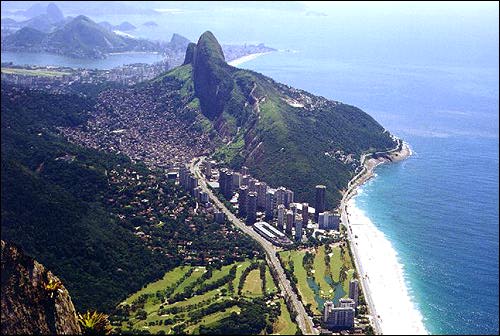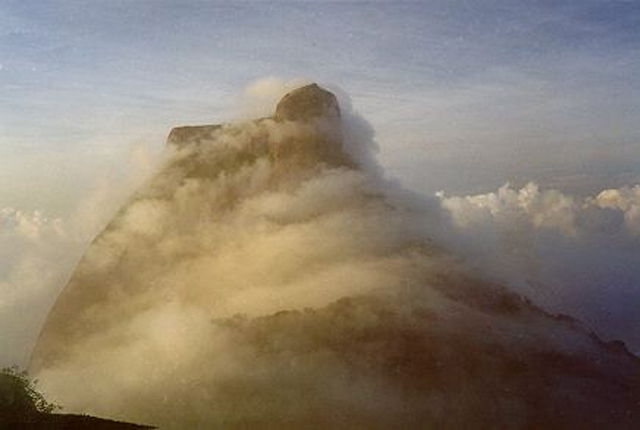 View from the Pedra da Gávea vista.
SHAMBALAH
The capital of AGARTA, a vast underground empire that, according to its believers, would have thousands of inhabitants in various cities. Some adepts sustain that this underground world has secret compartments within the base of the Queops Pyramid (the great pyramid of Egypt) that link to the Giseh Sphinx. According to the same people, there are three entries to Agarta located in Brazil:
Sete Cidades do Piaué
The "portal" found on the left side can be seen from 800 meters bellow could be the entry to such world. There are stories about climbers seeing lights coming out of the gaps around the inner edges of the supposed big door of the portal that blocks the way to Agarta.
Persian Mythology
According to it, there are four guardian stars in the sky on the cardinal points of the Earth and the Pedra da Gávea is protected by them:
Aldebaran - East
Some say that the rock is protected by independent cosmic powers that belong neither to the divine nor the evil forces known to men.
In 1937 two scientists were submitted to a clinic after spending the night at the rock, where they swear they saw a strange green light coming out of the gaps around the portal, from where they saw many human statues inside.
All those theories, and the fact that the rock is a champion in number of deaths among climbers, have aroused suspicions that the tomb of the Phoenician king with all his treasures may indeed be inside the rock. The death rate, which is explained by the total lack of precaution of amateur climbers, would be the toll of the curse placed upon those who dare violate the Kings burial site.
Conclusion
Although there is solid evidence that the rock was indeed a mark of some sort and there are many parts of it that deserved a more detailed study, the Pedra da Gávea stands as a place for hikers and climbers, and sometimes as a hideaway for outlaws. Its view, one of the most beautiful panoramas of Rio de Janeiro, is a privilege of those who dare defy gravity. Whether it was once the tomb of Badezir or the entry to Agarta, it is now just another site for Eco-tourists, and a not so well explored one. But the mystery of the rock will always be part of the lives of the Cariocas. There will always be someone to ask: Who would the authors of such a grand monument be? Why did they build it? Would they be the same as the people that sculpted the Nazca Lines? Or built the submerse walls of Bimini and the Bahamas? Would the builders have been Phoenician? If so, how did they manage to cross the seas to get here?
The mystery remains, while the face of a hidden giant keeps watching the sunrise as if waiting for someone to unveil its secrets. Any volunteers?
Many thanks to Pedro Lacaz do Amaral, who sent us all the written material used as reference for this article and many beautiful pictures of the rock and its surroundings; and
to the Live In Rio site, which let us use this magnificent image.
 Between São Conrado and Barra da Tijuca, Rio de Janeiro, a legendary mountain with the face of an ancient giant rises 842 meters above the sea level. |

Other history related articles on this site:
.
.
.
.
.
.
.
.
.
.
.
.
If you have a suggestion or history related article to submit, send it to:Comments?